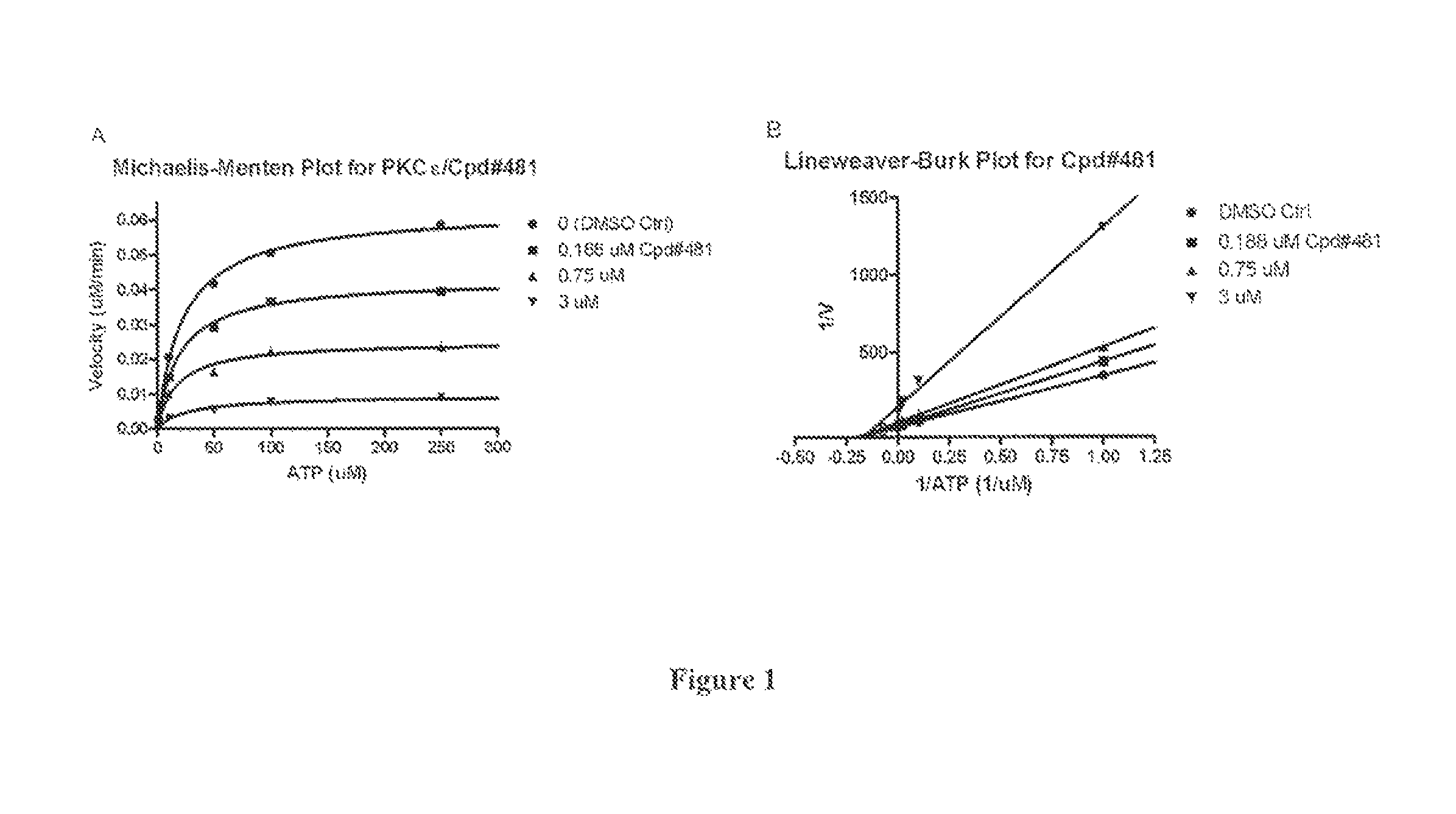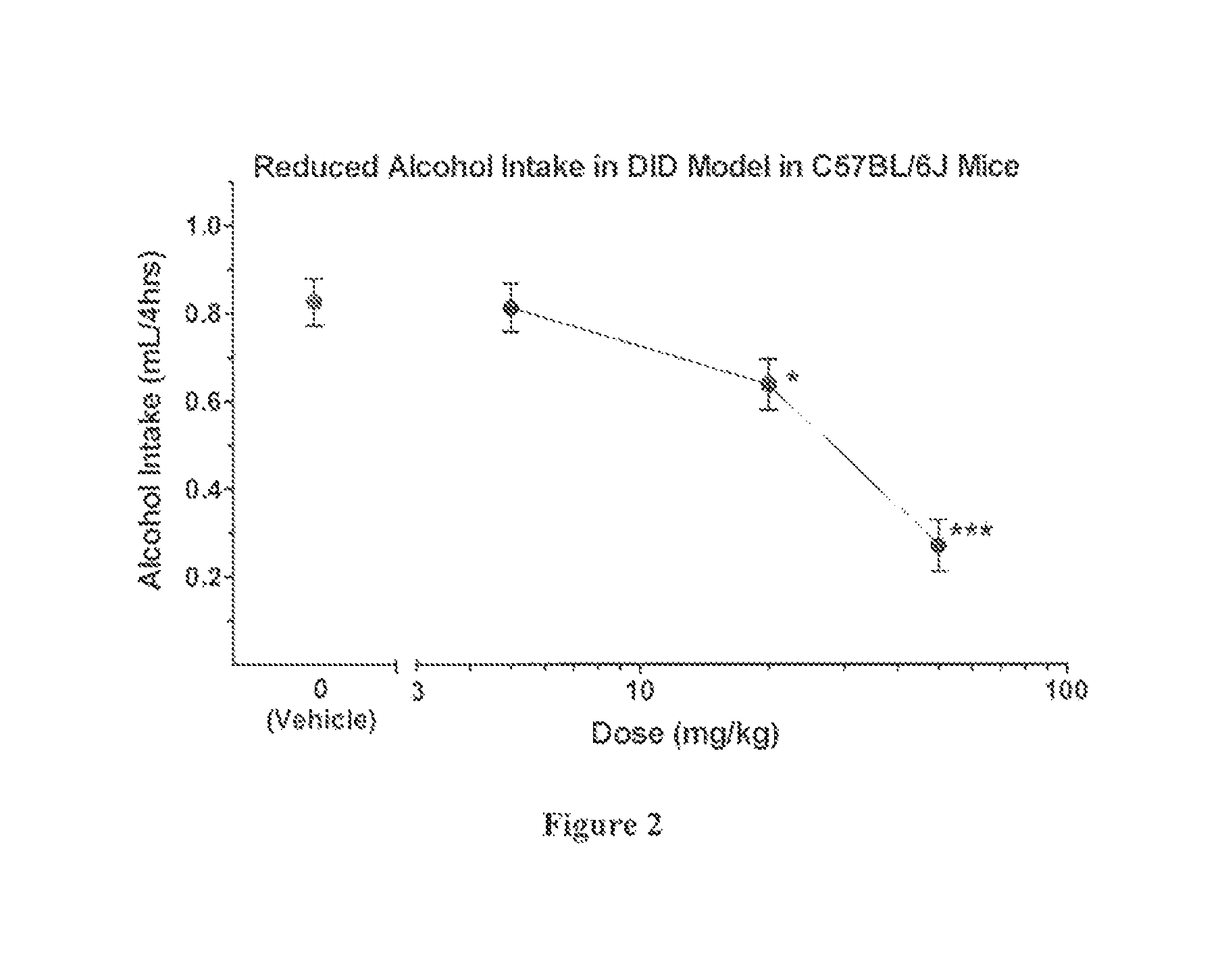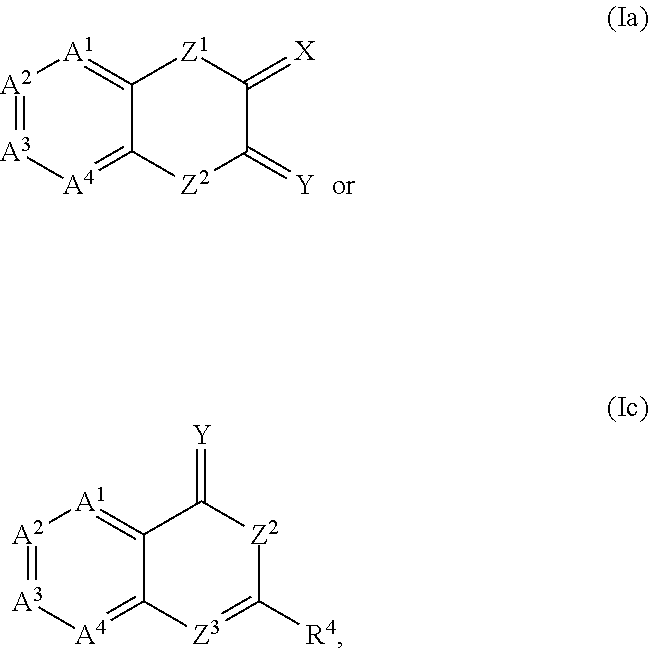Compositions and methods for treating alcohol use disorders, pain and other diseases
a technology for alcohol use disorders and compositions, applied in drug compositions, immunological disorders, metabolism disorders, etc., can solve the problems of nausea, hypotension and flushing, and carries a risk of significant liver, cardiac, nervous system toxicity, and clinical usefulness appears limited
- Summary
- Abstract
- Description
- Claims
- Application Information
AI Technical Summary
Benefits of technology
Problems solved by technology
Method used
Image
Examples
synthesis example 1
A. Synthesis Example 1
Compound 929: N-[3-(azepan-1-yl)propyl]-1-{[2-(4-chlorophenyl)-5-methyl-1,3-oxazol-4-yl]methyl}-N-methylpiperidine-4-carboxamide
[0218]
3-(azepan-1-yl)-N-benzyl-N-methylpropan-1-amine (A-2-1)
[0219]To a mixture of 3-(Azepan-1-yl)propan-1-amine (0.10 g, 0.64 mmole) in methylene chloride (5 mL) were added benzaldehyde (0.64 mmole) and NaBH(OAc)3 (0.63 g, 3.0 mmol). The reaction solution was stirred at room temperature for 3 h. Then, paraformaldehyde (200 mg) was added to the reaction mixture and stirring was continued for 6 h. 2N aqueous NaOH (2 mL) was added to quench the reaction, followed by addition of methylene chloride (30 mL). The organic layer was separated, dried over anhydrous Na2SO4, and filtered. The filtrate was evaporated to supply 3-(azepan-1-yl)-N-benzyl-N-methylpropan-1-amine (151 mg).
3-(azepan-1-yl)-N-methylpropan-1-amine (A-2-2)
[0220]3-(Azepan-1-yl)-N-benzyl-N-methylpropan-1-amine (100 mg) was dissolved in MeOH (20 mL) and to the solution was adde...
synthesis example 2
B. Synthesis Example 2
Compound 901: N-(3-(azepan-1-yl)propyl)-1-((2-(4-chlorophenyl)-5-methyloxazol-4-yl)methyl)piperidine-4-carboxamide
[0222]
2-(3-(Azepan-1-yl)propyl)isoindoline-1,3-dione (B-1-3)
[0223]The mixture of Azepane (2.3 mL), 2-(3-bromopropyl)isoindoline-1,3-dione (5.4 g) and potassium carbonate (5.5 g) in acetone (50 mL) was stirred at room temperature overnight. The solid was filtered and the filtrate was concentrated to provide 2-(3-(azepan-1-yl)propyl)isoindoline-1,3-dione, used without purification.
3-(Azepan-1-yl)propan-1-amine (Cpd A)
[0224]To a solution of 2-(3-(azepan-1-yl)propyl)isoindoline-1,3-dione (3.5 g) in Ethanol (20 mL) was added hydrazine (0.58 mL). The reaction mixture was reflux for 13 h and then cooled down to room temperature. TFA (2.0 mL) was added, the resulted white solid was filtered and the solvent was evaporated to give 3-(azepan-1-yl)propan-1-amine, used without further purification.
Ethyl 1-((2-(4-chlorophenyl)-5-methyloxazol-4-yl)methyl)piperidin...
synthesis example 3
C. Synthesis Example 3
Compound 481: 4-{(Z / E)-[4-(2-fluorobenzyl)-3-oxo-3,4-dihydro-2H-1,4-benzothiazin-2-ylidene]methyl}-N-(3-pyrrolidin-1-ylpropyl)benzamide
[0228]4-{(Z / E)-[4-(2-fluorobenzyl)-3-oxo-3,4-dihydro-2H-1,4-benzothiazin-2-ylidene]methyl}-N-(3-pyrrolidin-1-ylpropyl)benzamide can be similarly synthesized as in Examples 1 and 2, according to the scheme given below. The trans (Z) configuration with H1NMR (300 MHz, CD3OD), ppm: 7.94 (d, 2H), 7.89 (s, 1H), 7.77 (d, 2H), 7.36-7.25 (m, 2H), 7.16 (m, 2H), 7.12-7.02 (m, 4H), 5.44 (s, 2H), 3.52 (t, 2H), 3.30 (m, 4H), 3.14 (t, 2H), 2.15-1.98 (m, 6H). LCMS (ESI+) M / z: 516 (M+H).
[0229]
[0230]Characterization of Activity of PKCε Inhibitors
[0231]The utility of the compounds in accordance with the present invention as PKCε inhibitors antagonists may be readily determined without undue experimentation by methodology well known in the art, including many commercially available and validated bioassays. Examples are provided below.
[0232]In Vitr...
PUM
| Property | Measurement | Unit |
|---|---|---|
| weight | aaaaa | aaaaa |
| body weight | aaaaa | aaaaa |
| body weight | aaaaa | aaaaa |
Abstract
Description
Claims
Application Information
 Login to View More
Login to View More - R&D
- Intellectual Property
- Life Sciences
- Materials
- Tech Scout
- Unparalleled Data Quality
- Higher Quality Content
- 60% Fewer Hallucinations
Browse by: Latest US Patents, China's latest patents, Technical Efficacy Thesaurus, Application Domain, Technology Topic, Popular Technical Reports.
© 2025 PatSnap. All rights reserved.Legal|Privacy policy|Modern Slavery Act Transparency Statement|Sitemap|About US| Contact US: help@patsnap.com



